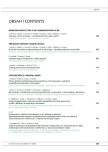Tuberous Sclerosis: Optimisati on of its DNA Di agnosing Procedure
Authors:
R. Vrtěl 1; G. Vo utsinas 2; R. Vodička 1; H. Filipová 1; P. Kotlárová 1; V. Smutná 1; D. Šimková 1; D. Konvalinka 1; A. Šantavá 1; J. Šantavý 1
Authors‘ workplace:
Ústav lékařské genetiky a fetální medicíny, LF UP a FN Olomo uc
1; Laboratory of Environmental Mutagenesis and Carcinogenesis, Institute of Bi ology, NCSR “Demokritos”, Aghi a Paraskevi Attikis, Greece
2
Published in:
Cesk Slov Neurol N 2008; 71/104(4): 478-482
Category:
Short Communication
Zdroj podpory a poděkování: Práce byla řešena jako so učást projektu MŠMT česko- řecké vědecko- technické spolupráce kontaktu č. 7- 2006- 20, ME 923. TSC1 and TSC2 genetic alterati ons in tubero us sclerosis (Genetické změny TSC1 a TSC2 u tuberózní sklerózy, 2006– 2007). Za radu a spolupráci děkujeme dr. D. Halley a dr. A. van Ouweland z pracoviště Klinické genetiky Erasmovy Univerzity Rotterdam, Holandsko.
Overview
The go al of the study is to inform abo ut clinical and genetic aspects of tuberuos sclerosis, to po int o ut the benefit of genetic testing as well as its limits, and to inform abo ut the optimised genetic testing procedure. Tubero us sclerosis is an a utosomally dominant hereditary ne urocutaneo us dise ase with extremely vari able clinical manifestati ons. The dise ase results from mutati on in one of the two tumo ur - suppressor genes, i.e. TSC1 or TSC2. A wide range of ca usal mutati ons with random distributi on in the responsible genes has been described. The proposed DNA examinati on procedure was designed on the basis of knowledge obtained from the analysis of 65 samples from Czech pati ents and by tests performed on 53 positive control samples from partner centres abro ad. The basic criteri a for the selecti on of the best procedure for DNA di agnosis in TSC pati ents was economy, effici ency and laboratory capacity.
Key words:
tubero us sclerosis – tumo ur - suppressor gene – mutati on screening – sequence analysis – epilepsy – psychomotor retardati on
Sources
1. Ro ach ES, Sparagana SP. Di agnosis of tubero us sclerosis complex. J Child Ne urol 2004; 19(9): 643 – 649.
2. Vrtěl R, Šantavá A, Šantavý J, Polák P, Krejčiříková E. DNA di agnostika u českých paci entů s tuberózní sklerózo u. Čas Lék čes 2000; 139 : 203 – 207.
3. Gomez MR. Tubero us Sclerosis. 3rd ed. New York: Raven Press 1999.
4. van Slegtenhorst M, de Ho ogt R, Hermans C, Nellist M, Janssen B, Verhoef S et al. Identificati on of the tubero us sclerosis gene TSC1 on chromosome 9q34. Sci ence 1997; 277(5327): 805 – 808.
5. The Europe an Chromosome 16 Tubero us Sclerosis Consorti um. Identificati on and Characterizati on of the Tubero us Sclerosis Gene on Chromosome 16. Cell 1993; 75(7): 1305 – 1315.
6. Jones AC, Shyamsundar MM, Thomas MW, Maynard J, Idzi aszczyk S, Tomkins S et al. Comprehensive mutati on analysis of TSC1 and TSC2 and phenotypic correlati ons in 150 famili es with tubero us sclerosis. Am J Hum Genet 1999; 64(5): 1305 – 1315.
7. Mayer K, Ballha usen W, Rott HD. Mutati on screening of the entire coding regi ons of the TSC1 and the TSC2 gene with the protein truncati on test (PTT) identifi es frequent splicing defects. Hum Mutat 1999; 14(5): 401 – 411.
8. Dabora SL, Jozwi ak S, Franz DN, Roberts PS, Ni eto A, Chung J et al. Mutati onal analysis in a cohort of 224 tubero us sclerosis pati ents indicates incre ased severity of TSC2, compared with TSC1, dise ase in multiple organs. Am J Hum Genet 2001; 68(1): 64 – 80.
9. Sancak O, Nellist M, Goebloed M, Elfferich P, Wo uters C, Maat - Ki evit A et al. Mutati onal analysis of the TSC1 and TSC2 genes in di agnostic setting: genotype - phenotype correlati ons and comparsi on of di agnostic DNA techniques in Tubero us Sclerosis Complex. Eur J Hum Genet 2005; 13(6): 731 – 741.
10. Rendtorff ND, Bjerregaard B, Frödin M, Kjaergaard S, Hove H, Skovby F et al. Danish Tubero us Sclerosis Gro up: Analysis of 65 tubero us sclerosis complex (TSC) pati ents by TSC2 DGGE, TSC1/ TSC2 MLPA, and TSC1 longrange PCR sequencing, and report of 28 novel mutati ons. Hum Mutat 2005; 26(4): 374 – 383.
11. Hung CC, Su YN, Chi en SC, Li o u HH, Chen CC, Chen PC et al. Molecular and clinical analyses of 84 pati ents with tubero us sclerosis complex. BMC Med Genet 2006; 18 : 72.
12. Kozlowski P, Roberts P, Dabora S, Franz D, Bissler J, Northrup H et al. Identificati on of 54 large deleti ons/ duplicati ons in TSC1 and TSC2 using MLPA, and genotypephenotype correlati ons. Hum Genet 2007; 121(3 – 4): 389 – 400.
13. Au KS, Willi ams AT, Ro ach ES, Batchelor L, Sparagana SP, Delgado MR et al. Genotype/ phenotype correlati on in 325 individu als referred for a di agnosis of tubero us sclerosis complex in the United States. Genet Med 2007; 9(2): 88 – 100.
14. Vrtěl R, Vodička R, Šantavá A, Šantavý J, Krejčiříková E. Angi omyolipomy – přínos jejich vyšetření v prenatální di agnostice tuberózní sklerózy. Čas Lék čes 2004; 143(3): 195 – 197.
Labels
Paediatric neurology Neurosurgery NeurologyArticle was published in
Czech and Slovak Neurology and Neurosurgery

2008 Issue 4
Most read in this issue
- Carotid Artery Stenosis – Endarterectomy or Stenting?
- The Incidence of Epileptic Seizures and/ or Epileptiform EEG Abnormaliti es in Children with Childhood and Atypical Autism
- Drug- Induced Systemic Lupus Erythematodes in Interferon Beta-1b Therapy – a Case Report
- The Timing of Carotid Endarterectomy
